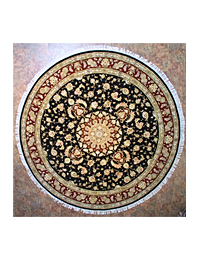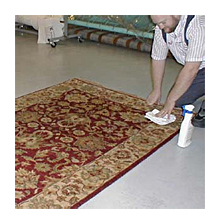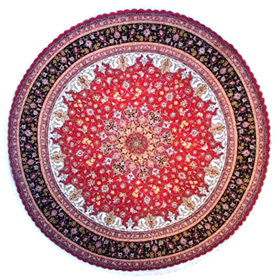Antique Oriental Rug and Carpet
This article contains:
Design Guide for Antique Oriental Rug and Carpet
Buyer's Guide for Antique Oriental Rug and Carpet
Selection Guide for Antique Oriental Rug and Carpet
General Care for Hand Made Antique Oriental Rug and Carpet
Product Reviews for Antique Oriental Rug and Carpet
Emergency Care for Antique Oriental Rug and Carpet
 An
authentic antique Antique Oriental Rug is a handmade carpet that is either knotted
with pile or woven without pile. Antique Oriental-design rugs made by
machine or any method other than hand knotting or hand weaving are not
considered authentic antique Antique Oriental Rugs. An
authentic antique Antique Oriental Rug is a handmade carpet that is either knotted
with pile or woven without pile. Antique Oriental-design rugs made by
machine or any method other than hand knotting or hand weaving are not
considered authentic antique Antique Oriental Rugs.
Antique Oriental Rugs normally come from a broad geographical region
extending from China in the east to Turkey in the west and the Caucasus in
the north to India in the south. People from different cultures, countries,
racial groups and religious faiths are involved in the production of
Antique Oriental Rugs.
Antique Oriental Rugs are organized after origin: antique Persian rugs,
antique Antolian rugs, antique Caucasian rugs, antique Central Asian rugs,
antique Chinese rugs, antique East Turkestan rugs and antique Tibetan rugs.
Uniqueness of Antique Oriental Rugs
Besides
their collection value, Antique Oriental Rugs are different from all others
in that their pile (usually wool) is tied to their foundations. That is why
they are referred to as antique hand-knotted rugs, and that, more than
anything, accounts for why they last so long- often 50-80 years in use. That
also accounts for their expense. The knot-count in a square inch of an
average Antique Oriental Rug is something like 100.
Judging Quality in Antique Oriental Rugs
Connoisseurs spend lifetimes weighing which Antique Oriental Rugs are worthy
of their collections. In the end it all comes down to taste, and for you
too, your own taste is finally what matters. Still, there are criteria by
which Antique Oriental Rugs are often judged that are commonly agreed on.
Some are elementary and nearly self-evident:
· Good Antique Oriental Rugs lie flat on their backs, without wrinkles or
ripples along their edges. Rugs with wrinkles, curled edges and so on,
besides disturbing the eye, wear prematurely.
· Some collectors love Antique Oriental Rugs that have faded into a low key,
innocuous absence of color, but, again, they should not be surprised when
their beloved rug is spurned by others. Good rugs have colors that resist
fading in normal light and bleeding when exposed to water.
· Antique Oriental Rugs in good condition are prized above those in bad
condition. Moth damage, holes, rips, spots and stains and missing ends and
edges are tolerable to most people only when rugs are really old.
· Some wool is better than other wool. Good wool has a noticeable glow. It
feels fleecy, perhaps a little oily, soft. It absorbs dye well and it takes
heavy use. Inferior wool is full of kemp and hair and is scratchy, dry,
lusterless and incapable of properly absorbing dye. Obviously, good wool is
preferable to bad wool. An Antique Oriental Rug or carpet is a piled or
flatwoven fabric hand-knotted in one of the traditional weaving areas of the
Middle or Far East. Genuine Antique Oriental Rugs and carpets come from Afghanistan,
China, India, Iran, Nepal, Pakistan, Tibet, Turkey, some of the southern
territories of the old Soviet Union (like Azerbaijan or Armenia), Balkan
countries like Romania and Albania, and some North African countries like
Morocco and Egypt. A Genuine Antique Oriental Rug and carpet is not made in Belgium
or anywhere else in Western Europe or in the United States. No genuine
Antique Oriental Rugs are made of nylon or polypropylene.
Antique Oriental Rug and carpet are
either knotted with pile or woven without pile. Antique Oriental Rug and carpet made
by machine or any method other than hand knotting or hand weaving are not
considered authentic
Antique Oriental Rug and carpet.
Antique Oriental Rug or Carpet Design Guide
Kashan
Kashan rugs are categorized amongst the finest of the Persian rugs do to there very high quality wool, very fine weaving and beautiful colors and designs. The field of these Kashan
rugs is generally decorated by a central medallion which terminates
at the upper and lower ends in the flowering coronets. The rest of
the field is closely decorated with flowers and vine tendrils. In
the four quarters a richly decorated band outlines a motif which
recalls the designs and colors of the central medallion.
Antique Oriental Rug and Carpet Buyer's Guide
Beautiful handmade rugs help set the overall scheme, color, and texture of a room, and most work as a decorative centerpiece. These beautiful handmade rugs also serve practical purpose of protecting your floors, retaining warmth, insulating against heat, and absorbing sound to minimize noise. Handmade rugs can also be used as an investment or family heirloom that is passed from generation to generation through the family linage.
What ever your
motivation in buying a handmade rug the process can be an intimidating
one. To help out, we have trained design professionals to help you select the perfect handmade rug for you. Our trained design professionals will answer any questions you have and if you live in the vicinity or our showroom we will even send a design professional out with your selection directly to your home to view your choices with you existing home décor.
Identifying a Authentic Persian and Oriental Handmade Rug
On the market today there are several machine made rugs that mimic the designs of Persian and Antique Oriental Rugs, but lack the quality, durability, workmanship and aesthetic beauty of a genuine Persian or Oriental handmade rug. Genuine Persian and Antique Oriental Rugs take several years to create by master weavers that have been perfecting the art throughout the generations. To qualify as an authentic handmade Persian or Antique Oriental Rug the rug must meet the following requirements:
- Must be hand woven
- Must of Originated from one of the following regions: Persia (Iran), China, Afghanistan, Turkey, Tibet, Nepal, Egypt, India, Pakistan.
- Design and Composition follows ancestral patterns.
Handmade vs. Machine-Made Rugs
As mentioned earlier, there are many machine made replicas of Persian and Antique Oriental Rugs on the market today. So you may ask why buy a handmade rug? The simple answer is quality and aesthetic beauty. But, let’s get into some detail:
- Machine made rugs do not nearly have the durability as a handmade Persian or Antique Oriental Rug, which can last many generations. The reason for this durability is that handmade rugs are made of natural occurring organic materials such as silk, natural wools, and vegetable dyes. Each handmade rug has individual knots that have been integrated into the loom (the foundation of the rug) ensuring that it will not shed with usage. Unlike machine-made rugs that use synthetic material and chemical dyes that will fade and deteriorate with age.
- Handmade rugs are one of a kind and there are no two pieces exactly alike compared to a machine made rug that comes off an assembly line.
- The beauty of a handmade rug can not be replicated by machine made processes. This ancient art of creating a handmade rug has been perfected over the years. Special secrete dying recipes and designs have been passed from generation to generation.
- Handmade rugs are used as investments since their value appreciates with age unlike a machine made rug that depreciates in value with age.
- Handmade rugs have a history and origin dating back thousands of years
Identifying a Handmade Rug from a Machine Made Rug
- Knott: Flip over the rug and if it’s a handmade rug the loops will be clearly visible.
- Fringe: Look at the fringe if it’s sewn on therefore it’s most likely a machine made rug. Handmade rugs on the other hand have there fringe going down the foundation of the rug.
- Flexibility: Handmade rugs can be folded and will not crack. Most machine made rugs will crack.
Antique Oriental Rug and Carpet Selection Guide
Shape

Determine if you are looking for a runner (best for long hallways), round, square, or arectangular rug.
Size
Determine the size you need. When measuring your space you want to take into consideration the relation of your furniture to the rug when determining the amount of floor you want to cover. Once you have measured the amount of space that you wish to cover the best method is to look at the standard sizes of handmade rugs and see which standard rug size fits the closest. Take into consideration that handmade rugs can be a few inches long or short in length or width since they are not made by machine processes.
Standard Sizes:
Small Rugs
2 x 3
2 x 4
3 x 5
4 x 6 |
Medium Rugs
5 x 7
5 x 8
6 x 9
7 x 10 |
Large Rugs
8 x 10
8 x 11
9 x 12
10 x 13
10 x 14 |
Palace Sized
Any size over 10 x 15 |
Color
Determine the colors you need. When choosing the colors of your handmade rug the optimal method of décor is to choose the handmade rug first since it is one of a kind and echo the colors in your home décor. But, this is seldom the case so therefore when choosing the colors in your handmade rug the best method is to look at samples from your cushions, paint, wallpaper, bedspread, and curtains and to pick and choose the colors that you want to be echoed in the rug.
Design
Look at the designs available in your colors and size. The designs
available in Oriental and Persian rugs are unlimited do to the
uniqueness of each piece because each piece is unique these handmade
rugs are named by the city they where made in.
Materials
Make sure the materials are of utmost quality. The materials used in a Persian or Antique Oriental Rugs determine its value and longevity. Persian and Antique Oriental Rugs are made of all-natural fibers such as wool, cotton and silk.
Wool is the most widely used and resilient material used in Persian and Antique Oriental Rugs. But, not all wools are created equal in these rugs. The highest quality wools are sheered once a year from the sheep during spring time while the lesser quality wools are sheered many times a year from the sheep so they are of lesser quality and luster.
Cotton is used usually as the foundation of handmade rugs because it is strong, doesn’t lose its shape and can be spun into strands thin enough to allow fine weaving.
Silk is the finest material of which a
rug can be woven. Silk can be used exclusively in the rug so
therefore the rug is purely silk or it can be used with a combination
of wool where the silk outlines the motifs.
Price/Value
When choosing the amount you want to spend for a handmade rug make sure to determine an ideal price range that is within your budget. Also remember price has a strong correlation with the quality, age, and materials used. Antique and semi antique rugs are highly prized and higher grade wools and higher percentages of silk in handmade rugs increase the value of the piece. Also when buying a handmade rug one has to take into consideration the difficulty of the design, the countless hours taken into knotting the piece.
Where to Buy your Handmade Rug
Initially prior to the emergence of the Internet, rugs where exclusively sold within furniture stores and individual retailers. The retail experience allows one to touch and feel the rugs they are interested in and make an immediate purchase. But, the effort involved in visiting these stores and selecting the right rug takes time and money. Online shopping on the other hand has made it extremely convenient to purchase a luxury handmade rug. We at
Antique Oriental Rug and Carpet General Care Guide
The Wonders of Wool
Oriental and Persian Rugs are generally made of wool and are easily and economically maintained. Rugs of wool are extremely durable and consistently out-perform other materials. Unlike other fibers, wool is much more resilient, cleans better and stays clean longer.
 Cleaning Cleaning
Your trusted professional Persian and Antique Oriental Rug cleaners will insure a skilled cleaning that brings out the richness of color and softness of the wool. Depending on the amount of traffic, a professional washing is recommended every three to six years for the cleaning of your Persian and Antique Oriental Rug.
Rotation
To insure even wear, your rug should be rotated once a year. Depending on the traffic, the rotation may vary from six months to two years.
Vacuuming
Persian and Antique Oriental Rugs, like most rugs should be vacuumed on a regular basis to remove dirt and restore life to the fiber. Be sure not to vacuum the fringe.
Padding
A quality pad used under your rug helps protect it from dirt, wear and slippage. We will be happy to provide you with the correct padding.
Restoration
In case of damage, just about any problem has a solution with a professional restoration. Old and antique rugs sometimes need to be rewoven where worn and restored to life. Newer rugs rarely in need of repair. An experienced professional must always be consulted in these matters.
Antique Oriental Rug and Carpet Emergency Care Guide
Spills & Pet Stains
1. Whether it is wine, coffee, coolaid, urine, paint or whatever, the first
step is to remove as much of it as possible from the Antique Oriental Rug and carpet
- as soon as possible. Paper towels work well. Keep blotting until you have
got as much out as possible.
2. After blotting, many spills will require diluting. If it is clear that
much of the spilled
 substance is still in the Antique Oriental Rug and carpet,
dilute it with water (assuming that the substance is water soluble)- as much
water as necessary. That may mean a half cup for a small spill or it may
mean a quart of water for a major spill. Don’t get the rug sopping wet
unless you need to. substance is still in the Antique Oriental Rug and carpet,
dilute it with water (assuming that the substance is water soluble)- as much
water as necessary. That may mean a half cup for a small spill or it may
mean a quart of water for a major spill. Don’t get the rug sopping wet
unless you need to.
Please note that some Antique Oriental Rug and carpet have unstable dyes that may
run if you put water on them. But they are a small minority of all rugs.
Sometimes you simply must take a chance.
3. Now back to blotting. Get as much out as possible.
4. If the Antique Oriental Rug or carpet has become wet in the process, you needn’t panic.
Chances are that it can stay wet for at least several days without harm.
Still, you will have to manage the wet rug and promote drying. If the rug is
quite wet, you may have to elevate it to promote air circulation under it.
You might just stuff some wadded up newspapers under it. You may wish to
play a fan on the rug to circulate air.
5. If the Antique Oriental Rug or carpet is still stained after all your efforts, consider
taking it to a professional Antique Oriental Rug or carpet washer as soon as you can. Very often spills
come out in the wash.
6. Do not use spot removers on Antique Oriental Rug and carpet that are formulated
for use on wall to wall carpeting. They will harm the wool pile of your rug.
If your Antique Oriental Rug or carpet has become sopping wet from plumbing problems, a leaking roof,
as a result of firefighting or anything else, the situation may not be as
bad as you fear. A rug can stay wet for at least several days before it is
harmed. Still, you must do the best you can to manage it. Even though the
water and the rug are dirty, your priority most likely will be to get the
rug dry. You can have it washed later.
Journey to deliver Quality Antique Oriental Rug and Carpet.

We are
constantly looking for products and information about rugs. Please contact us to send us your ideas. |
 An
authentic antique Antique Oriental Rug is a handmade carpet that is either knotted
with pile or woven without pile. Antique Oriental-design rugs made by
machine or any method other than hand knotting or hand weaving are not
considered authentic antique Antique Oriental Rugs.
An
authentic antique Antique Oriental Rug is a handmade carpet that is either knotted
with pile or woven without pile. Antique Oriental-design rugs made by
machine or any method other than hand knotting or hand weaving are not
considered authentic antique Antique Oriental Rugs.
 Cleaning
Cleaning substance is still in the Antique Oriental Rug and carpet,
dilute it with water (assuming that the substance is water soluble)- as much
water as necessary. That may mean a half cup for a small spill or it may
mean a quart of water for a major spill. Don’t get the rug sopping wet
unless you need to.
substance is still in the Antique Oriental Rug and carpet,
dilute it with water (assuming that the substance is water soluble)- as much
water as necessary. That may mean a half cup for a small spill or it may
mean a quart of water for a major spill. Don’t get the rug sopping wet
unless you need to.